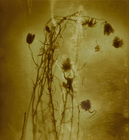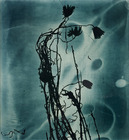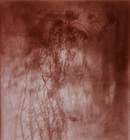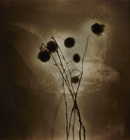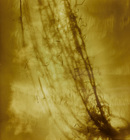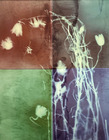Still Life
Nick Croggon
The photographs of Amanda Williams contain a certain type of stillness. It is not the stillness of a statue, which suggests a condition of monumental and permanent fixedness. It is instead a stillness limned by movement, of action briefly arrested and about to recommence. Williams’ still images bristle with the activity of the natural world that they depict, like the stillness of a pond beneath whose surface a plethora of life forms dart and interact. To experience Williams’ work is to experience a moment of quiet that makes this activity suddenly perceptible. Williams’ work gives new meaning to the idea of the still life.
Williams’ newest body of work comprises a series of still lifes of daisies: billy buttons, sticky daisies and alpine daisies. Williams encountered these flowers between December 2022 and February 2023, during some of her regular visits to Taungurung and Gunaikurnai Country, in the Alpine National Park in Victoria, and Walgalu and Ngarigo Country in the Kosciuszko National Park.
The flowers live in the Park’s alpine herbfields, high on the plains above the tree-line where they are buffeted by winds, low temperatures and coverings of snow. The plants, like other members of the Asteraceae family, survive in these conditions by remaining in constant motion, turning their faces to the sun as it moves across the sky. This strategy has allowed Asteraceae to thrive not just in the alpine herbfields, but in environments across the world—they can today be found on every continent except Antarctica.
In the history of art, the still life is a genre of painting or photography characterised by frozen tableaus of plants, food or other domestic items. These static tableaus are often understood as metaphors or allegories—the image of rotting fruit or a skull, for example, is an allegory for human mortality. Williams’ images of Asteraceae appear, in the first instance, as still lifes in this sense–their scraggly stems and drooping flowers allegories for the precarity of life in a harsh environment. Indeed, the alpine herbfields contain many precious species and ecologies under threat from the environmental crisis that enfolds us all.
The story of the Asteraceae, however, is not one of precarity. These flowers are machines whose strategy for the capture and transformation of sunlight is so successful that it has proliferated across the globe. As such, Williams’ Asterceae photographic still lifes could be understood as allegories for the global history of photography itself.
This is neat enough. But the details of Williams’ photographs demand closer attention. They are in fact not exactly photographs, but rather photograms, or what Williams has called “light pressings”. Williams created a “camera” by placing the flowers on a sheet of orthochromatic copy sheet film between two sheets of Perspex, which was then exposed to the light and heat of the summer alpine environment. The chemical interaction of the environment with the silver halide crystals in the copy film resulted in a negative image of the flower, and a spray of colours. Williams then into the darkroom, manipulating the negative further with chemicals and extra colours, before printing onto the photographic paper now on the walls of the gallery. This is a process in which the separation between plant and photograph, image and real, is constantly collapsed.
The result is a set of still lifes that vibrate with movement. Here there is no easy legibility of figure and ground. Instead, the stems and petals of the flowers blend into the marks and imperfections created during the reproductive process, and their forms are further confused by a series of doublings and inversions both within the photographs, and across the series. These traces of natural form and technological process are suspended in a shallow, murky depth, whose eddies and currents arrest the eye and enforce a kind of slow looking.
Ultimately, then, in both their content and their viewing, Williams’ still lifes are not static representations or allegories, but rather a set of ongoing techno-organic operations—what Williams has elsewhere described as “becoming-photograph”.
The “becoming-photographs” of Williams’ current exhibition are part of a much broader body of work, focused on the Great Dividing Range. Over the past ten years, Williams has spent a considerable amount of time visiting and imaging this environment, employing a range of photographic processes to express the complexity of life she has found there. In doing so, Williams has sought to work against the settler colonial logic that has captured this landscape over the past two hundred years–a logic which seeks to both exclude the Traditional Owners of the land, and to fix and control its various forms of life. The photography whose history is allegorised by the Asteraceae is, as Williams’ well knows, deeply entangled with this logic. In the nineteenth century settlers in Australia used photography as a way to represent the Australian landscape as unpeopled, and to preserve and control its wildness.
In previous works in the Great Dividing Range project, Williams has evoked this history through the use of nineteenth century techniques, especially black and white photography. The colourful light pressings of the current exhibition, however, point to an alternative history. In an 1842 report (whose title gives the current exhibition its name), the British inventor, chemist and photographer Sir John Herschel described a series of experiments similar to the ones Williams’ has carried out, in which the interaction of environment and photographic chemicals resulted in the production of errant colours. These colours, Herschel observed, were not indexical traces of the real, but rather products of the chemical processes of photography itself.
As photography developed over the course of the 19th century, Herschel’s colours were forgotten as photography refined its key goal: the objective representation of nature. The presence of arbitrary colours produced by the photographic process were not welcome. It was not until the 20th century, when colour could be both standardised and commercialised that it was permitted back into the space of photographic representation.
Williams presents Herschel’s errant colour as the starting point for an alternative history of photography: what film scholar Thomas Elsaesser would call a “possibilist” or “counterfactual” media history. This is not the familiar narrative of photography’s linear progress towards ever greater objectivity, but rather a history of experimentation and the accidental, one which dwells in the entanglement of chemical and environmental processes, a stillness that brackets infinite variability.
Williams’ colourful still lifes ultimately, then, stand as emblems for a reopening of photographic history, an alternative path to and through our image present. At Australia’s current historical juncture, we have never needed such openings more.
—Nick Croggon is an arts writer, editor of Memo Review, and the events and programs officer at The Power Institute at the University of Sydney. He lives on Gadigal land.











